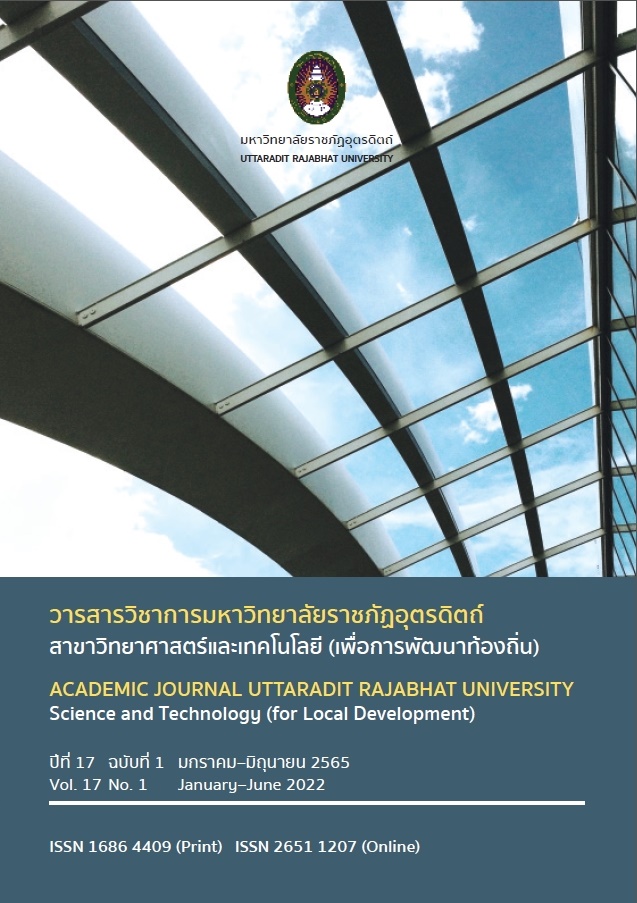A MODEL OF INTERCONNECTED LEARNING FOR ENHANCING AN ACTIVE CITIZENSHIP IN A LOCAL COMMUNITY DEVELOPMENT OF RAJABHAT UNDERGRADUATE STUDENTS
Main Article Content
Abstract
This research aimed to examine the characteristics of active citizenship in Rajabhat University students, develop an instructional management from Interconnected Learning Theory to enhance active citizenship for Rajabhat University students as local community development, and investigate the efficiency of the instructional management from Interconnected Learning Theory to enhance active citizenship for Rajabhat University students as local community development. This research and development study included samples of 760 Rajabhat University undergraduate students and 40 Rajabhat University students as experimental group. The research instrument was evaluative forms on characteristics of active citizenship which was calculated with statistical descriptive analysis. It also presented the comparison of average scores on the digital literacy of the students between before and after implementation of the instructional management with paired t-test. It was found that the characteristics of active citizenship in Rajabhat University students was at high level in every aspect. And the instructional model of Interconnected Learning Theory for enhancing active citizenship as local community development for Rajabhat University students included learning areas of six lessons about digital literacy through 7 strategies of interconnected learning together with 7 learning methods which took 12 weeks of class meetings of 36 hours. As for the experimental group of 40 students, it was found that the mean scores on the characteristics of active citizenship in Rajabhat University students increased in every aspect at highest level ( = 4.65) which was higher than the mean scores before implementation of the Interconnected Learning Model (
= 4.20) with statistical significance at .05 (p = .000). It could be concluded that the instructional model of Interconnected Learning Theory for enhancing citizenship as local community development in Rajabhat University students was a proactive instructional approach from experiential learning among the learners, instructors, and community that emphasizes on development of learning for transformative changes by connecting roles within the society and granting the students opportunity to design and share responsibility together in their community which would lead to social space development of sustainability.
Downloads
Article Details

This work is licensed under a Creative Commons Attribution-NonCommercial-NoDerivatives 4.0 International License.
References
ทิศนา แขมมณี. (2551). ศาสตร์การสอน องค์ความรู้เพื่อการจัดกระบวนการเรียนรู้ที่มีประสิทธิภาพ. กรุงเทพฯ: สำนักพิมพ์แห่งจุฬาลงกรณ์มหาวิทยาลัย.
ปรเมธี วิมลศิริ. (2559). ยุทธศาสตร์ชาติ 20 ปี อนาคตประเทศไทย เพื่อความมั่นคง มั่งคั่ง ยั่งยืน. สืบค้น 20 กุมภาพันธ์ 2563, จาก http://planning.pn.psu.ac.th/plan_doc/procedure/docs_procedure/300_1498813858.pdf
ประเวศ วะสี. (2558). มาทำความรู้จัก Gen A กัน. ใน สุดใจ พรหมเกิด, บรรณาธิการ. อ่านสร้างสุข : Gen A พลังอ่านเปลี่ยนเมือง. หน้า 6. กรุงเทพฯ: แผนงานสร้างเสริมวัฒนธรรมการอ่าน สำนักงานกองทุนสนับสนุนการสร้างเสริมสุขภาพ.
วรรณากร พรประเสริฐ, เทียมจันทร์ พานิชย์ผลินไชย, ปกรณ์ ประจัญบาน และน้ําทิพย์ องอาจวาณิชย์. (2563). การพัฒนาแบบวัดและเกณฑ์ปกติความเป็นพลเมืองดิจิทัล ของนิสิตนักศึกษาในสถาบันอุดมศึกษา = The development of student digital citizenship scale and norms in higher education institutions. วารสารศึกษาศาสตร์ มหาวิทยาลัยนเรศวร. 22, 217-234.
วิชัย วงษ์ใหญ่. (2561). กระบวนทัศน์ใหม่ในการพัฒนาหลักสูตร. กรงุเทพฯ: โอเดียนสโตร์.
ศรีสุนันท์ ประเสริฐสังข์, สุธาสินี วังคะฮาต, พัชราภรณ์ ดวงเนตร, และวิยะดา ไวยศรีแสง. (2559). ความรับผิดชอบต่อสังคมของนักศึกษามหาวิทยาลัยราชภัฏร้อยเอ็ด = The students’ corporate social responsibility of Roi-et Rajabhat University. ใน ICMSIT 2016: International Conference on Management Science, Innovation, and Technology 2016, (น. 204-211). กรุงเทพฯ: มหาวิทยาลัยราชภัฏสวนสุนันทา.
สำนักงานคณะกรรมการการอุดมศึกษา. (2551). กรอบแผนอุดมศึกษาระยะยาวฉบับที่ 2 (2551-2565). สืบค้น 25 กุมภาพันธ์ 2563, จากhttp://www.mua.go.th/assets/img/pdf/HEPlan_book.pdf
Bell, David V.J. (2016). Twenty-first century education : Transformative education for sustainability and responsible citizenship. Journal of Teacher Education for Sustainability. 18(1), 48-56.
Frecky, K. (2011). Foundations of service learning. Retrieved July 8, 2020, from http://samples.jbpub.com/9780763759582/59582_CH01_ FINAL.pdf
Gliem, J. A. (2003). Calculating, Interpreting, and Reporting: Cronbach’s Alpha Reliability Coefficient for Likert-Type Scales. Retrieved July 8, 2020, from https://scholarworks.iupui.edu/bitstream/handle/1805/344/Gliem+&+Gliem.pdf?sequence=1
GuildHE. (2016). Active citizenship : The role of higher education. Retrieved July 8, 2020, from http://www.guildhe.ac.uk/wp-content/uploads/2016/11/6710-Guild-HE-Active-Citizenship-Report-44pp.pdf.
Haynes, C. C., & Thomas, O. (2001). Finding Common Ground: A Guide to Religious Liberty in Public Schools. Tennessee: First Amendment Center.
Kozak, Stan, & Elliott, Susan. (2014). Connecting the dots : Key strategies that transform learning from environmental education to citizenship and sustainability. Canada: Learning for Suatainable Future.
Ng, W. (2012). Can We Teach Digital Natives Digital Literacy? Computers & Education, 59, 1065–1078.
O’Conner, Mason., Lynch, Kenny, & Owen, David. (2011). Student-community engagement and the development of graduate attributes. Education+Training. 53, 100-115.
Rahnama, Hossein. (2017). What the Rise of Interconnected Learning Means for Higher Ed. Retrieved July 8, 2020, from http://www.gettingsmart.com/2017/01/interconnected-learning-means-for-higher-ed/.


